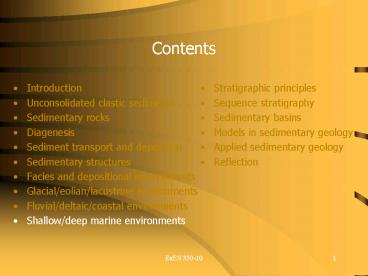Contents - PowerPoint PPT Presentation
1 / 29
Title:
Contents
Description:
Shallow/deep marine environments. Stratigraphic principles. Sequence stratigraphy ... major source of sediment for the deep sea, and is a setting where slumps ... – PowerPoint PPT presentation
Number of Views:134
Avg rating:3.0/5.0
Title: Contents
1
Contents
- Introduction
- Unconsolidated clastic sediments
- Sedimentary rocks
- Diagenesis
- Sediment transport and deposition
- Sedimentary structures
- Facies and depositional environments
- Glacial/eolian/lacustrine environments
- Fluvial/deltaic/coastal environments
- Shallow/deep marine environments
- Stratigraphic principles
- Sequence stratigraphy
- Sedimentary basins
- Models in sedimentary geology
- Applied sedimentary geology
- Reflection
2
Shallow/deep marine environments
- Shallow marine environments
- Shallow seas can be subdivided into clastic and
carbonate-dominated systems, depending mainly on
sediment supply and climatic setting - Idealized models predict a general decrease of
grain size with water depth (i.e., away from the
shoreline) however, this simple picture is
complicated by a large number of factors (e.g.,
shelf bathymetry)
3
(No Transcript)
4
(No Transcript)
5
(No Transcript)
6
(No Transcript)
7
(No Transcript)
8
Shallow/deep marine environments
- Shallow marine environments
- Storm-dominated clastic shelves ideally exhibit a
transition from predominantly wave-rippled sands
in the upper shoreface, to alternating sands and
muds (tempestites with hummocky cross
stratification) in the lower shoreface, to muddy
facies below storm wave base - Tide-dominated clastic shelves may exhibit
erosional features, sand ribbons, and sand waves
with decreasing flow velocities, commonly
associated with mud-draped subaqueous dunes
tidal sand ridges (tens of m high, many km
across) are characteristic of shelves with a high
supply of sand - Bioturbation can obliterate many primary
sedimentary structures in shelf environments
9
(No Transcript)
10
Shallow/deep marine environments
- Shallow marine environments
- Shallow seas within the photic zone are the
premier carbonate factories - Carbonate platforms can cover continental shelves
or epicontinental seas, when the conditions for
carbonate production (temperature, salinity,
light conditions) are favorable - Isolated platforms (atolls) are found in shallow
seas surrounded by deep water, like extinct
volcanoes
11
(No Transcript)
12
(No Transcript)
13
(No Transcript)
14
(No Transcript)
15
(No Transcript)
16
(No Transcript)
17
(No Transcript)
18
Shallow/deep marine environments
- Shallow marine environments
- Carbonate ramps exhibit processes and
characteristics comparable to clastic shelves,
with carbonate sands and muds ultimately
producing a seaward transition from grainstone to
mudstone, commonly with similar sedimentary
structures - Rimmed carbonate shelves consist of a coral reef
or carbonate sand barrier at some distance from
the mainland the shelf lagoon can be up to many
tens of kilometers wide - Boundstones dominate the reef facies
- Shelf lagoon facies are mostly fine-grained and
ultimately lead to the formation of mudstones and
wackestones
19
(No Transcript)
20
Shallow/deep marine environments
- Deep marine environments
- The continental slope is a major source of
sediment for the deep sea, and is a setting where
slumps can occur - Debris flows and turbidity currents are the main
mechanisms of transport from the continental
slope into the deep sea these processes can be
triggered by external forcing (e.g., an
earthquake) or by the slope reaching a critical
state as a result of ongoing deposition - Debris-flow deposits and turbidites are often
genetically related - Turbidites can be both clastic (commonly leading
to the formation of wackes) or calcareous
21
Animation
22
(No Transcript)
23
Shallow/deep marine environments
- Deep marine environments
- Submarine canyons at the shelf edge (commonly
related to deltas) are connected to submarine
fans on the ocean floor - Contrary to debris flows, turbidites exhibit a
distinct proximal to distal fining - Submarine fans share several characteristics with
deltas they consist of a feeder channel that
divides into numerous distributary channels
bordered by natural levees and are subject to
avulsions - Proximal fan (trunk channel)
- Medial fan (lobes)
- Distal fan
24
(No Transcript)
25
(No Transcript)
26
Shallow/deep marine environments
- Deep marine environments
- Basal Bouma-divisions have the highest
preservation potential updip upper
Bouma-divisions are more common downdip - Turbidite lobes characterize the medial fan and
may exhibit the most complete Bouma sequences - The Bouma-model is increasingly challenged,
because many turbidites do not conform to it
(e.g., high-concentration turbidites) - Contourites are formed by ocean currents and
commonly represent reworked turbidites
27
(No Transcript)
28
(No Transcript)
29
Shallow/deep marine environments
- Deep marine environments
- Pelagic sediments primarily have a biogenic
origin - Calcareous ooze (e.g., foraminifera) forms above
the calcite compensation depth (CCD) at 4000 m
depth - Siliceous ooze (e.g., radiolarians, diatoms)
forms between the CCD and 6000 m depth where
silica dissolves it lithifies into cherts - Hemipelagic sediments consist of fine-grained
(muddy) terrigenous material that is deposited
from suspension - Eolian dust is an important component (50) of
hemipelagic (and pelagic) facies - Black shales have a 1-15 organic-matter content
and form in anoxic bottom waters






























![Top Content Writing Agencies in India 2022 [Updated 2022] PowerPoint PPT Presentation](https://s3.amazonaws.com/images.powershow.com/9707624.th0.jpg?_=20220110052)
